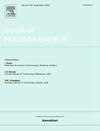Precise implementation of the Goldstein current model for self-powered neutron detectors and comparative analysis of its approximate approaches
IF 2.3
3区 工程技术
Q1 NUCLEAR SCIENCE & TECHNOLOGY
引用次数: 0
Abstract
Self-powered neutron detectors (SPND) have been commonly used in reactors to monitor neutron flux density based on their response current. The Goldstein model is a typical Monte-Carlo model used to calculate steady-state SPND current. Compared with other models, the conductive current at steady state due to the space charge effect was included and calculated in the Goldstein model, and some approximate approaches were introduced due to the limitations of the used Monte Carlo software or for the sake of fast calculations. Hence, considering that Geant4 can trace the trajectories of charged particles in electric field, a more precise implementation of the Goldstein current model—accounting for charge transport under the actual electric field—has been carried out based on Geant4 in this work. In the precise implementation, the response current is accurately calculated by simulating the electron transported under the actual electric field, and actual charge density distribution is also obtained. Compared with the experimental result, the relative deviation of the response current calculated by the precise implementation is 8.99 %, while for the three approximation approaches, the deviations are 9.49 %, 10.15 %, and 11.39 %, respectively. In addition, six parameters affecting the detector response were scanned within the conventional variation range for comparative analysis of the three approximate approaches. The results show that the approximate approach #1 always gives the most precise result and that considering the practical application situations the insulator resistivity is the most key parameter affecting the space charge effect. It is worth mentioning that when the peak electric potential in insulator is a few kV or even less, the approximate approaches are acceptable, especially for the situation of quick calculation.
自供电中子探测器Goldstein电流模型的精确实现及其近似方法的比较分析
自供电中子探测器(SPND)已广泛应用于反应堆中,根据其响应电流监测中子通量密度。Goldstein模型是用于计算稳态SPND电流的典型蒙特卡罗模型。与其他模型相比,Goldstein模型中包含了由于空间电荷效应引起的稳态导电电流,并对其进行了计算,同时由于现有蒙特卡罗软件的限制或为了计算速度快,引入了一些近似方法。因此,考虑到Geant4可以追踪电场中带电粒子的运动轨迹,本工作基于Geant4更精确地实现了实际电场下考虑电荷输运的Goldstein电流模型。在精确实现中,通过模拟实际电场作用下的电子传输,精确计算出响应电流,并得到实际电荷密度分布。与实验结果相比,精确实现计算的响应电流的相对偏差为8.99%,而三种近似方法的相对偏差分别为9.49%、10.15%和11.39%。此外,在常规变化范围内扫描了6个影响探测器响应的参数,对三种近似方法进行了对比分析。结果表明,近似方法1给出的结果最精确,考虑到实际应用情况,绝缘子电阻率是影响空间电荷效应的最关键参数。值得一提的是,当绝缘子内峰值电势为几kV甚至更小时,近似方法是可以接受的,特别是对于快速计算的情况。
本文章由计算机程序翻译,如有差异,请以英文原文为准。
求助全文
约1分钟内获得全文
求助全文
来源期刊

Annals of Nuclear Energy
工程技术-核科学技术
CiteScore
4.30
自引率
21.10%
发文量
632
审稿时长
7.3 months
期刊介绍:
Annals of Nuclear Energy provides an international medium for the communication of original research, ideas and developments in all areas of the field of nuclear energy science and technology. Its scope embraces nuclear fuel reserves, fuel cycles and cost, materials, processing, system and component technology (fission only), design and optimization, direct conversion of nuclear energy sources, environmental control, reactor physics, heat transfer and fluid dynamics, structural analysis, fuel management, future developments, nuclear fuel and safety, nuclear aerosol, neutron physics, computer technology (both software and hardware), risk assessment, radioactive waste disposal and reactor thermal hydraulics. Papers submitted to Annals need to demonstrate a clear link to nuclear power generation/nuclear engineering. Papers which deal with pure nuclear physics, pure health physics, imaging, or attenuation and shielding properties of concretes and various geological materials are not within the scope of the journal. Also, papers that deal with policy or economics are not within the scope of the journal.
 求助内容:
求助内容: 应助结果提醒方式:
应助结果提醒方式:


